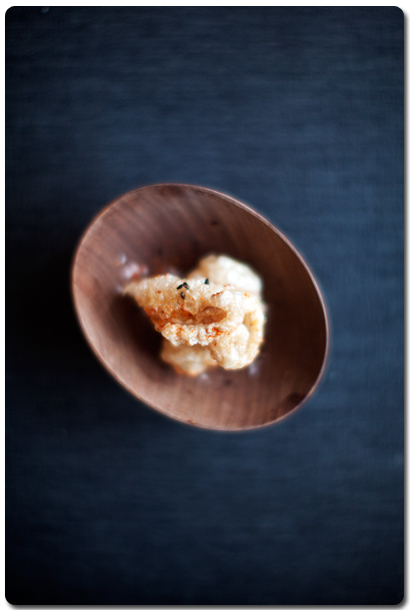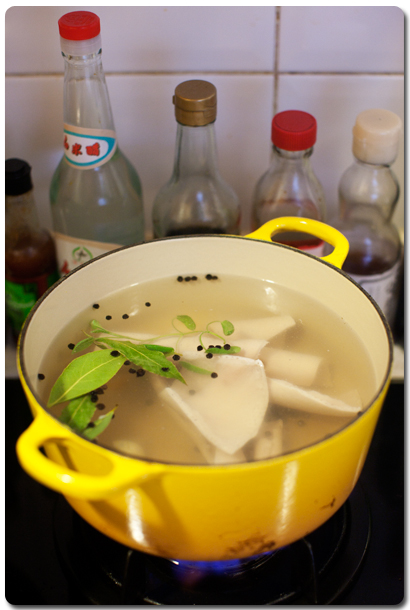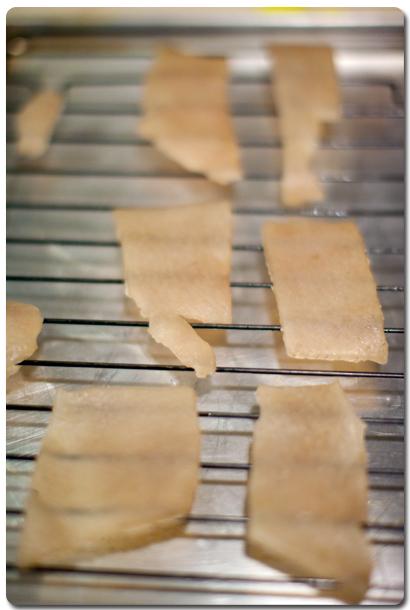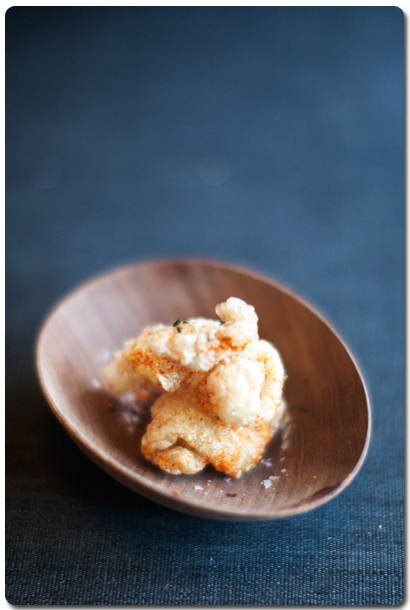Monday, October 15th, 2012...2:34 pm
Chicharon

Fun fact: as a kid, one of my (many) nicknames was ‘Chich’, which was short for chicharon – a Filipino snack of deep fried pork rinds. (Variations are also popular in Spain, parts of Latin America, and – more recently – areas of the US and Europe.) I continue to be baffled by this, since I hated the stuff when I was growing up, which was probably due to how the only types I’d tried, up until maybe 5 years ago, were supermarket no-frills brands that were bland, greasy, not crispy or crunchy, and horribly unappetising.
However, since I’m finally trying my hand at making bacon, I found myself with a 2.5kg slab of pork belly, skin on, and decided that instead of making bacon with the rind on, I’d separate the skin and try my hand at making chicharon.

Although time-consuming, making chicharon is not a complicated process – the skins need to be simmered (so the protein breaks down), dehydrated, then deep fried. Most domestic kitchens aren’t equipped with dehydrators, so what most people seem to have done is to leave the boiled skins on a rack placed over a baking sheet in their oven set on the coolest temperature (or with the door slightly wedged open to vent it) overnight.
Admittedly, this is one of those recipes that I probably should have thought through a little more before diving into. I’m pretty sure I’ve bitched before about my lack of built-in oven in our tiny Hong Kong kitchen, but the one feature I still loathe is its 90 minute timer (after which the oven shuts off automatically). This means that if I want to say confit some duck legs or slow roast a shoulder of pork, I’ll have to sit myself at home for a good 4-8 hour stretch, restarting the timer every 90 minutes, instead of being able to chuck it into the oven and forget about it.

That said, when it came time to deep fry those dehydrated shards of pig skin, and they puffed up perfectly into crispy, crunchy, airy, well-seasoned crackers of porcine deliciousness, I have to say it was worth it. All those hours of plucking pig hair out of the skin, and being under house arrest for an entire Saturday while I dutifully reset the timer over and over again were completely worth it, and now I know what I’ll be doing whenever I next find myself with another piece of pig skin on my hands.
Note: I’ve had some nicely crunchy but bland chicharon before in various restaurants before, and I’ve also read online that the way to combat this is to season the water that the skins are first cooked in quite aggressively, so I just threw together some aromats for a basic court-boullion. You can substitute what I’ve used with whatever you’ve got on hand (or leave out the herbs, if you want), as long as you salt it well (think pasta cooking water levels of saltiness). I also really liked the slight tang that the vinegar gave the cooked chicharon, so that’s the only other thing I’d advise against leaving out.

Chicharon
fresh pig skin, with any stray hairs removed (shaved/blowtorched/plucked/waxed/epilated – whatever tickles your fancy)
4 fresh bay leaves
5 fresh sage leaves
5 cloves of garlic, bruised with the flat of a knife
2g black peppercorns
30ml white wine vinegar
2g sea salt
To fry and serve
canola oil
flaky sea salt
shichimi tõgarashi (optional)
Trim the pig skin into manageable-sized pieces – I cut mine into squares or rectangles that were around 2×4 inches. You may want to use a pair of kitchen scissors for this, but I found that a sharp chefs knife (and if yours is too blunt for the task, then it’s high time you sharpen it anyway!) did the trick. Remove as much fat as possible from the skin, and place into a large, heavy-based pot or Dutch oven. Fill the pot with enough water to cover the skins by about 2 inches, add the bay, sage, garlic, peppercorns, vinegar and salt. Slowly bring to a boil over medium-low heat.
Once the court-boullion comes to a simmer, cook for 90 minutes, or until the skin is soft enough to be pierced with the tines of a fork. Remove the pieces of pig skin to a cutting board. (You can strain the cooking liquid and add this to any soups or stocks if you want, for body, but I discarded it because it was very heavily seasoned and acidic.)
Scrape all of the fat off the pieces of skin with a knife. You want to make sure you can every last bit, so spend a little time on this – chicharon is fried pig skin, not fat, and the fat will just get in the way of the skin puffing up properly. Pat the pieces of skin dry with kitchen paper, then lay the pieces flat on a rack set over a baking sheet. Place in a dehydrator if you have one, or in an oven set to it’s minimum temperature for 8-12 hours or until completely dry. (Your oven should be preferably set to around 50-70ºC, but if it doesn’t go that low, just set it to its minimum and wedge the door open with a wooden spoon.)
When the skins are completely dehydrated, they will sort of resemble shards of amber, or yellowish-brown pieces of acrylic or glass. Once cool, these pieces will keep in an air-tight container at room temperature for a couple of weeks (though you may want to run them for another hour or so in the oven before frying them, if you keep them for more than 2-3 days).
Heat about 2cm of oil in a heavy-based saucepan or Dutch oven to 190ºC. Once the oil is hot, drop the pieces of skin in, in small batches, and let them puff up. (They’ll expand quite a bit, so don’t overcrowd your pan. If you’ve dehydrated them properly, the oil shouldn’t spit or splatter.) Turn the pieces a couple of times, then drain on a triple-layer of kitchen paper. Repeat with the rest of the skin.
Toss the puffed pieces of chicharon with salt and shichimi tõgarashi (if using), and serve immediately.

4 Comments
February 24th, 2013 at 7:33 am
Just came back from the Philippines and bought a 2 bags of microwave chicharon from SM. I did not expect much but it was actually good. Shame it takes so much time to make them. Where did you get pig skin?
February 24th, 2013 at 9:09 am
Hey Lory – oh wow microwave chicharon?? How does that work? And yeah it is a bit of a pain, especially the dehydrating bit, but I think it was totally worth it. Plus it’s not the sort of thing I’d indulge in every day so it makes me savour the treat a little more. :)
I got my pig skin from the side of pork belly I was curing for bacon. I rarely see pork belly with skin on in supermarkets in HK, but I think if you tried one of the smaller butchers you could probably put in a request for it? There’s a chance they may even give you the leftover skin as trimmings for (next to) nothing!
March 4th, 2013 at 8:23 am
Thanks for the info. Microwave chicharon is packed like microwave popcorn and works the same way.
Dehydrating with an oven is a pain. Am trying to get my hands on a dehydrator but they are quite expensive in HK.
A friend told me I could get chicharon at Worldwide Plaza in Central. Will check that out. Apparently they get new delivery every Thursday.
March 5th, 2013 at 3:15 pm
Lory: Interesting…. if you happen across any good chicharon (microwave- or otherwise) in HK do let me know!
And yeah, dehydrators are massively expensive, it’s a bit ridiculous. A friend of mine in Singapore just got one though and I’m super jealous! Even if I could afford one, anyway, my kitchen just doesn’t have the space for anymore appliances. :\
BTW, I was in Pacific Gourmet yesterday and noticed that they sell large ish chunks of pork belly or pork loin with the rind on – just in case you decide to give it a stab. And you can easily cook the rest of the meat in some other preparation. :)
Leave a Reply